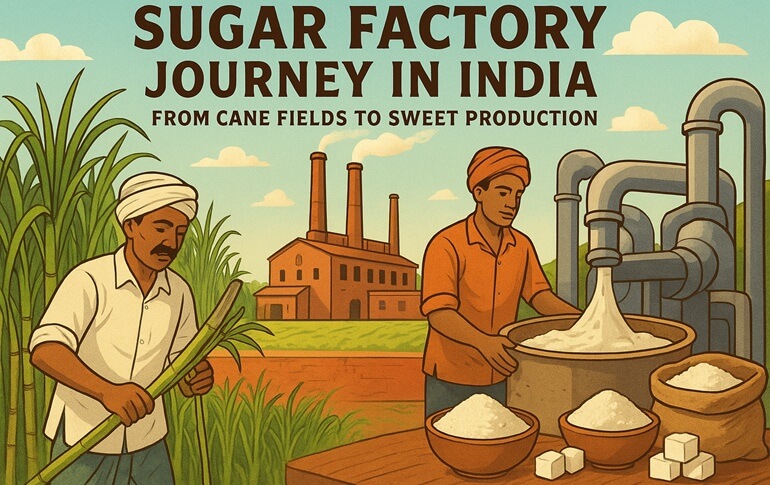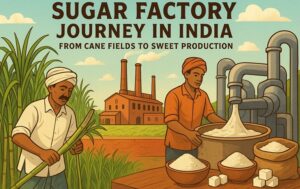Sugar Factory Journey in India: From Cane Fields to Sweet Production

The 2nd biggest sugar producer in the world, India, sweetens lives, economies, and dreams. Running like a golden artery across the agricultural heartland of India, the sugar industry spans from the sun-drenched plains of Uttar Pradesh to the buzzing mills of Maharashtra. It drives rural lives, sparks industrial engines, and feeds a thousand auxiliary enterprises flourishing on its by-products. Sugar is a cultural cornerstone, a seasonal celebration, and a sign of sustenance, not just a commodity.
The industry finds its origins deep within India’s agricultural spirit, where generations of farmers grow sugarcane optimistically and harvest with tenacity. Supporting millions, feeding industrial units, and influencing policy frameworks, it has carved its place into the history of India’s economic story. The journey speaks of human effort, technical elegance, and industrial force working in tandem as cane turns into crystal, not just of manufacturing.
From farm to sugar factory, this journey highlights India’s excellence in balancing innovation with nature. It is a story of convergence among tractors, turbines, and time-honored customs. The sugar industry, however, doesn’t just sweeten India’s exports; with every grain it produces, it sweetens its growth, wealth, and promise. Also Know about: 5 Most Convincing Characteristics of Engineered Wood
Cultivation: The Foundation in India’s Fields
Covering the vast agricultural canvas of India, sugarcane is a resilient kharif crop resting deep in the rich loam of the Gangetic plains and Deccan plateau beneath monsoon-fed sky. Farmers guided by seasonal rhythm and traditional wisdom sow this golden reed where sun, earth, and rain combine in perfect harmony.
While Maharashtra, Karnataka, Tamil Nadu, and Bihar ring with the rustling of thriving crops, Uttar Pradesh shows its green cane fields like a royal scroll. Equipped with tradition and tenacity, tiny and marginal farmers grow every stalk with dignity and will. From their calloused hands, they irrigate with care, harvest with enthusiasm, and drive an industry that finishes in excellence, woven into the fabric of India’s rural economy.
Sugar Factories: The Industrial Powerhouses
Relentless energy and precision from the biggest sugar factories in India propel the agro-industrial engine of the country. Harvested cane is transformed into refined sugar by a perfect cycle of:
- Crushing
- Extraction
- Clarifying
- Evaporation
- Crystallization, and
These sugar factories in India provide jobs, support rural economies, and promote growth in the engineering, transportation, and chemical industries.
Burning bagasse generates power; molasses is used to make ethanol; press mud is used to make bio-manure, thus ensuring nothing is wasted. While corporate and public mills use modern technology to speed up output, cooperative mills engage farmers directly. These factories export goods internationally and provide sugar locally. They promote ethanol blending initiatives and reduce reliance on fossil fuels. Through relentless consistency, they enhance the economy in every process and highlight India’s industrial might.
Allied Industries & Economic Impact
- Sugar mills produce ethanol, boosting India’s green energy and biofuel goals
- Bagasse powers cogeneration plants, supplying surplus electricity to the grid
- Molasses feeds alcohol production, supporting beverage and industrial ethanol sectors
- Chemical industries rely on molasses for solvents, acids, and other derivatives
- Ethanol blending reduces crude oil imports and enhances energy security
- Sugar by-products enable zero-waste operations across allied manufacturing units
- Rural employment surges through direct and indirect job opportunities in sugar zones
- Transportation, packaging, and logistics industries thrive around sugar-producing regions
- Ancillary units produce paper, boards, and biofertilizers from sugar waste
- Biofuel policies encourage investment in sugar-linked industrial infrastructure and technology.
Export Potential & Global Standing
The 2nd largest sugar exporter in the world, India, has a notable influence on the global sugar market. It has contributed almost 12.21% to global exports in 2023. Well-thought-out strategies and strong manufacturing capacity have caused this predominance.
India has had sugar surpluses in recent years, which has led the government to adopt export limits and incentives to control domestic stock levels and stabilize prices. Aiming to equalize local supply with foreign demand, the government allowed the export of 1 million metric tonnes of sugar during the 2024-25 Season.
Southeast Asia, the Middle East, and Africa have become important markets for India’s sugar exports. Somalia, Afghanistan, Sri Lanka, and Libya came out as leading Indian sugar importers as of April 2025. These trade ties help to increase India’s foreign currency income as well as maintain its position as a consistent supplier in the global sugar sector.
Through farsighted export strategies and by fostering international alliances, India keeps strengthening its position in the global sugar trade, therefore supporting economic development and global food security. India’s sugar exports during 2024–25 are 2.87 lakh tonnes.
Technological Advancements & Sustainability Measures
- Farmers adopting drip irrigation to conserve water efficiently
- Smart irrigation systems boosting yield and reduce water waste
- Scientists developing high-yield, disease-resistant sugarcane seed varieties
- Mills recycling wastewater to minimize environmental impact
- The biggest sugar factories in India installing treatment plants for sustainable water use
- Co-generation units converting bagasse into renewable electricity
- Sugar factory reducing carbon emissions through clean energy
- Automation enhances precision and productivity in sugar processing
- Bio-composting using press mud to enrich agricultural soil
- Mills installing energy-efficient turbines and boilers
- Solar panels supplementing energy in eco-conscious sugar mills
- Green practices improving sustainability and global competitiveness.
The Road Ahead: Policy and Innovation
Steering its sugar industry with visionary policy and revolutionary innovation, India confidently marches into the future. Setting high goals to reduce fossil fuel use and spark a green revolution, policymakers undertake the ethanol blending initiative. They change the Minimum Support Price (MSP) to ensure farmers get fair value and economic dignity. They adjust export subsidies to open global possibilities and strengthen India’s trading position.
Digital agriculture, on the other hand, is a quiet revolution empowering farmers with real-time data, precise tools, and smart analytics. Every change and invention helps India to reinforce the basis of its sugar sector and map a forward course towards sustainability and global leadership.
Concluding Remarks
Every harvest and every crystallized grain lifting millions, India’s sugar industry brings life into the heartlands of the country. It inspires farmers, energizes companies, and lifts economies—becoming not just an industry but a living, beating lifeline. It drives rural livelihoods, strengthens agro-based businesses, and sparks the fires of related industries from transportation to biofuels.
While maintaining aspirations for global commerce, it helps food security. The industry shapes its identity as a great pillar in India’s agro-industrial structure by transforming cane into commerce and sweat into sweetness, standing tall, rushing ahead, and sweetening the country’s path with tenacity, wealth, and purpose.







